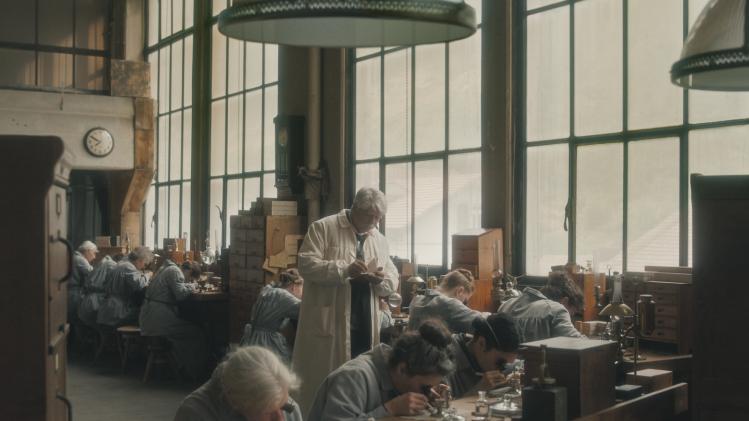
Given their similar spellings, a young student might be forgiven for confusing the words “anarchism” and “anachronism.” The concepts named by each term, on the other hand, are relatively easy to distinguish. But Unrest—a film based on Russian political philosopher Pyotr Kropotkin’s 1870s travels among the anarchist watchmakers of the Swiss Jura Mountains—mixes together anarchistic opposition to coercive social organization with a refusal of the dictates of time.
A straightforward (but intentional) anachronism captures the film’s central theme. At a meeting of an anarchist collaborative, one of the members reads out a letter from an affiliated organization in Campania, Italy, where there was an anarchist uprising in 1877. Its authors write, in part, “An anarchist society that organizes itself without authority exists always, like a seed beneath the snow, buried under the weight of the state.” The quotation comes nearly word-for-word from a book by British anarchist Colin Ward, inspired substantially by Kropotkin but published in 1973, nearly a hundred years after the action of the film. It neatly describes Kropotkin’s understanding of anarchism as an organic form of organization whose natural origins make it a superior alternative to the artificial, hierarchical, and oppressive organization of the state and industry. Unrest dramatizes resistance to a form of tech-reliant, state-facilitated capitalist control that was just getting started in the 1870s, was well-established by the 1970s, and is hypercharged today. A meditative reflection on this form of control, director Cyril Schäublin’s film manages to avoid heavy-handedness while leaving no doubts about where its sympathies lie.
The technology at the center of Unrest is time itself. The workers of the watch factories of the Jura Mountains—still the center of Swiss watchmaking today—both produce time through their craft and are increasingly ruled by it. The film’s title contains a double meaning, referring to both the social agitation rampant in the region and a watch’s “unrest” or “balance wheel.” The so-called “heart of the watch,” the unrest wheel oscillates back and forth to turn the watch’s gears and produce the familiar ticking that constitutes much of this film’s spare soundtrack. In one scene, Josephine, an unrest-wheel fitter, and other workers are timed by a lab-coat-clad forerunner of today’s management consultants to see how long it takes them to assemble the parts of the watch. Some of the workers resist this Taylorist intrusion by working slowly on purpose, but others worry that they will be fired if they don’t raise their work rate.
An anarchist collaborative in the town tries to counter this accelerating transition from an artisanal to a mechanistic form of production. It provides affordable health insurance—which is otherwise unavailable to the single women working at the factory—sends money to fellow anarchists undertaking a rail strike in Baltimore amid violent repression, and, in an effort to raise funds for unions around the world, stages a play reenacting the short-lived Paris Commune of 1871. Technology is deployed against anarchist workers both in the factory and outside it: four workers, including Josephine, are fired after they are photographed at a meeting of the collaborative. But technological surveillance and control doesn’t turn the anarchists into technophobes: they swap photographic portraits of anarchist figures like baseball cards and rely on the telegraph for international communications. In fact, their extensive telegraph networks at this early stage of the so-called “first globalization” made them better connected than the mainstream press. In one scene, the factory’s director general, Roulet, recommends anarchist newspapers to a colleague. “Thanks to their network,” he claims, “I was able to anticipate the crisis [the Panic of 1873] and save money.” (The scene originated in research by historian Florian Eitel, who served as a consultant for the film.)
Director General Roulet also runs unopposed for the Grand Council of Bern, one example of the close-knit cooperation between the state and industry that is featured throughout the film. When Kropotkin first arrives in town, ostensibly to make a map of the region, he is prevented from crossing a road by two police officers who are helping stage a photo shoot for the factory’s new catalogue. “We are in the middle of a sales crisis on an international, even global level,” the officers tell him, as if they work for the watch factory themselves. “We have to fight against it.” The copy for the new catalogue is to read: “Nowadays, one cannot imagine a man without a watch in his hand.”
This, in a sense, is precisely what Schäublin is asking viewers to do: imagine human beings unburdened of time and other technologically manufactured realities. “We really think it’s 4:30,” Schäublin said during an interview about the film, “It’s so concrete. And I think this is interesting, because it’s such a construction. It’s so made up.” Unrest defamiliarizes time by exposing the absurdities and flaws in the emerging technological regime. There are, for example, four slightly different times in use in one town: municipal time, local time, factory time, and church time. The factory runs eight minutes ahead of municipal time and its bosses dock the pay of workers who show up late as a result of the discrepancy. When the telegraph breaks down, no one knows what time it is, and the police are at a complete loss as to how to set the clocks. The coercive power of the state and industry is revealed as a power to turn congenial fictions into something like second nature. A failure to resist is therefore, in large part, a failure of imagination. Another world is not only possible; it is waiting for us underneath the accumulated layers of imposed convention that distort our relations to one another, our work, and ourselves—a seed beneath the snow.
Schäublin’s first film explored the endpoint of the developments just beginning in the 1870s. A pitch-black comedy, Those Who Are Fine (2017) is set in a dreary, dystopian Zurich and follows a worker at a call center selling low-priced internet access. She runs a scam on its elderly customer base by posing as a granddaughter in need of emergency funds. The characters in the film are constantly fumbling with identity numbers, wifi passwords, and banking codes. They can talk to each other of nothing but the best available cell-phone data plans and half-remembered movie plots. Many of these conversations are between police officers, who, just as in Unrest, provide regular comic relief. Where Unrest defamiliarizes our technologically constructed and saturated form of life by depicting a time before it was fully realized, Those Who Are Fine does so by exaggerating it. Where the anarchists of Unrest establish a natural, cooperative form of social organization as an alternative to private and public power, the characters of Those Who Are Fine are swallowed up by an artificial environment where their every thought and action is mediated by technology and bureaucracy. They are much more concerned about connecting to the internet than to each other—and scarcely able to do either.
Schäublin shoots both films at a distance from the characters and, in Unrest, sometimes confines them to the bottom or corner of the frame. (One reviewer complains, not without justification, that the characters can get lost behind the subtitles.) The effect in Unrest is very much in keeping with its anarchist theme. It decentralizes the characters, portraying them as organic parts of their environment rather than operators above and outside it. Both Josephine and Kropotkin explicitly deny that they are protagonists. And Schäublin abjures overtly dramatic action, casting mostly non-actors, who give understated performances, and soft-pedaling all the conflict. When one worker is arrested for not paying her taxes, the police are exceedingly polite and she acquiesces meekly. The film’s gentle tone—or what the jury at the Berlin Film Festival called its “strange and unsettling calm”—is in keeping with its view of anarchism, which one also finds in the recent writings of political scientist James C. Scott. This is an anarchism rooted less in a violent revolutionary impulse than in the quiet resistance of ordinary people to top-down surveillance and rule.
Schäublin’s method of decentering the main characters and deflating the drama may turn off some critics, but it allows the viewer an unusual range of freedom to survey the screen without being coerced into this or that emotion or identification. Unrest’s anti-drama invites contemplation. One almost feels as if it is not individuals or groups that are in conflict in the film so much as the ideas themselves. At the same time, it implicitly rebukes the charismatic magic of individual personality sold so relentlessly through so much of our popular entertainment. Indeed, it suggests, however quietly, that the proud individualism of our current culture is the flipside of, and feeble consolation for, the conformity of our economy and our politics. We are compensated for our alienation with fantasies of self-realization that are never fulfilled, only refreshed.
Anarchist activity in the Jura Mountains began with a split in the First International between Marxian socialists and the anti-statist followers of Mikhail Bakunin, who detected a latent authoritarianism in Marxism. Occupy Wall Street and the Democratic Socialists of America notwithstanding, the century and a half that followed seems to have brought dead ends to both socialist movements. Marxist doctrine was used to justify brutal authoritarianism, arguably in just the way Bakunin predicted. Anarchism, at least of the kind Unrest represents, seems to suffer from the opposite problem. If an anarchist society always exists beneath the surface, it may also lack the impetus to ever rise above it. Unrest ends with a stopwatch hanging evocatively from a tree. It finally, mercifully, stops ticking and the camera pans left to an unfocused forest. We hear nothing, only birdsong and the rustling of the trees.
